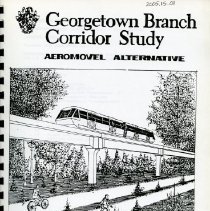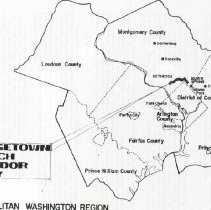Library Record
Images


Metadata
Object ID |
2005.15.1 |
Title |
Georgetown Branch Corridor Study-- Final Report |
Object Name |
Report/ Survey |
Author |
Sur Coester Aermovel International, SA |
Published Date |
1989 |
Description |
Submitted to Montgomery County Department of Transportation, Office of Planning and Project Development. Deals with proposed action, alternatives considered, and environmental consequences of a new light rail connector between Bethesda and Silver Spring. Pages 5 and 6: 1 Introduction Mobility is an activity of society which is always changing in its demands and seems difficult in its provision. Economic growth and population growth results in additional demands for mobility and greater options for technology to serve. 1.1 Purpose and Scope of Study Within mid 1980s, a land parcel between Silver Spring and Georgetown(Washington DC) ceased to be used for a freight railroad. With the urbanization and commercialization within the down county area, question arose whether this alignment could be used for public transit. Consultants retained by Montgomery County Government and State of Maryland evaluated this route. In May 1989 they issued a Final Report about potential for use by LRT Light Rail combined with a system of trails for cyclists and hikers. This Aeromovel study borrows much of the evaluation from that LRT Final Report, but focuses on the potential to use a new urban transit technology which will require less ground space within the land parcel. The technology was developed in Brasil and recently was opened for public operation in Jakarta Indonesia. It is called Aeromovel. This report evaluates the benefits and liabilities to be found with use of Aeromovel. The format of this presentation conforms to the earlier report. 1.2 Background After 90 years of operation, the single track railroad from Rosemont to Georgetown DC was legally closed. The alignment afforded an option within Montgomery County to consider new uses principally as natural recreational trails and provision of public transit. Given the urbanization and commercial development between Silver Spring and Bethesda as compared with the residential development of the rest of the branch, the local government determined that only the Bethesda Silver Spring portion would require dual use. With various private individuals, firms and public agencieso involved in future use of this alignment, no consensus was seen for type of use. There are potentially conflicting opportunities which are not limited just to the transport or the recreation issues. Additionally, the technology suggested for public transit requires removal of many mature trees and placement of high current electric within an alignment devoid of power lines. Since a Brasilian firm has developed an urban transport technology not using overhead wires and requiring the removal of fewer trees, merit was established to evaluate Aeromovel development. 1.3 Transportation Problems Modern urbanization, both commercial and residential, has occurred within Montgomery County during the last 40 years. The pre 1950 planning and infrastructure had not been prepared for such current realities. In part, the result has created a number of employment and commercial centers within the county that are not adequately linked together or linked to residential areas. Two of these major centers are along the western boundary with the District of Columbia between Silver Spring and Bethesda. Montgomery County's largest business complex is Silver Spring, an unincorporated area centered at the north western tip of the District of Columbia. Weekday employment has grown to 31 300 mixed between profession and retail firms. Over 4 000 dwelling units exist, with concentrations in multi rise apartment buildings. Regional growth estimates suggest a further 17 000 employment positions will be created and an additional 7 000 dwelling units will be built. Bethesda is a pre 1965 post war suburb which has been transformed into a pseudo city character during the last decade. Current employment levels average 29 800 while intra area housing is 5100 units. A further 22 000 jobs will be generated within the next decade and residential units will increase by at least 1700 units. Both areas possess the character of classic, modern CBDs. Both areas have been provided with under ground WMATA 'rail service to Washington DC and various Virginia communities within the Greater Washington Metropolitan Area. Within this area, only pre 1950 road alignments exist for handling all surface transport demands. Most roads are radial, based on original linkage to Washington City. Cross routes are limited and constantly strained when handling this demand. Within this corridor a single track railway alignment has existed since 1888. With the shift of land use and economic changes the original and post 1945 needs for this railway freight service have ceased. As a result, the alignment has been abandoned to commercial common carrier operation. However, the physical alignment has been retained. 1.4 Project Objectives This study's objective is to evaluate the potential for joint use of the former railroad alignment for both public transport needs and recreational/environmental needs between Silver Spring and Bethesda. Based on the May 1989 consultant's report, consideration is made to install a new technology within the corridor as a means to improve conditions for contiguous communities, reduce capital costs for the transport component, and provide a transport facility which encourages safe, frequent patronage without detriment to the park line beauty. |
